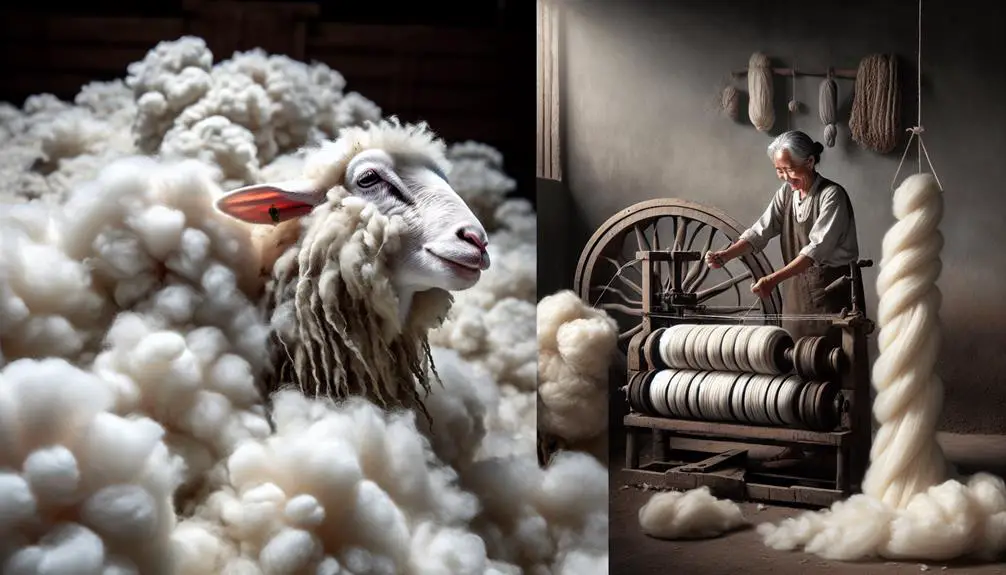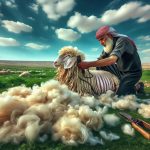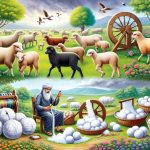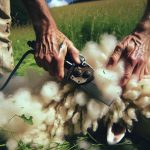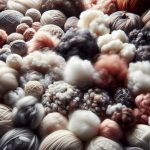Wool is a natural fiber that's super versatile. It comes from sources like sheep, goats, and rabbits. It's famous for being strong, soft, and great at keeping you warm. The manufacturing process involves cleaning and sorting the fibers. Different types of wool have unique qualities. But don't stop here! There's a lot more to learn about wool and its fascinating properties.
Table of Contents
Key Takeaways
- Natural textile fiber with unique structure and properties.
- Derived from animals like sheep, goats, and camels.
- Known for insulation, softness, and durability.
- Used in garments, carpets, and insulation products.
- Wool grades vary from super fine to coarse.
Definition of Wool
Wool, a natural textile fiber sourced from animals like sheep and goats, is renowned for its unique characteristics and versatile applications. This protein fiber is quite fascinating when you explore its structure. It consists of three main components: the outermost layer known as the cuticle, the cortex in the middle, and the medulla at the core. These elements give wool its strength, softness, and insulating properties.
What sets wool apart is its durability, making it a preferred choice for various products. Its softness adds a luxurious feel, whether you're wearing a cozy sweater or resting on a wool rug. Additionally, the insulating properties of wool are exceptional; it keeps you warm in winter and cool in summer due to its natural ability to regulate temperature. Knowing that wool comes from different animals like sheep, goats, yaks, camels, and angora rabbits further showcases its versatility in meeting different needs.
Sources of Wool
So, when we talk about the sources of wool, it's quite fascinating. You've got sheep, right? They're like the OGs of wool providers.
But then, there are cashmere goats, yaks, camels, and even fluffy Angora rabbits in the mix!
Wool Production
Sheep, goats, yak, and rabbits are all valuable sources of the textile fiber known as wool. Wool production involves various animals like cashmere goats, camels, and angora rabbits, each providing unique qualities to the fibers.
The process includes shearing the animals to collect the wool, followed by scouring and sorting to remove impurities and guarantee quality. Factors such as fibre thickness, length, and waviness play an important role in determining the quality of the wool.
Once the wool is prepared, it's used in fabric production to create a wide range of products. Understanding these steps in wool production helps in appreciating the effort and skill involved in producing this versatile and valuable natural fiber.
Types of Wool
After exploring the process of wool production, it's fascinating to learn about the various animals that serve as sources for this versatile textile fiber. Sheep are the primary source of wool, offering different qualities based on breed. Cashmere goats produce fine cashmere wool, while llamas contribute llama wool known for its softness. Angora rabbits are another source, providing soft white wool fiber. Additionally, camel fleece is valued for its soft undercoat wool.
Each animal source yields wool with unique characteristics, making it essential to understand the different wool fiber types for various uses. By recognizing the animal sources and their contributions, one can appreciate the diversity in wool quality and choose the most suitable type for different applications.
Types of Wool
Okay, let's talk about the different types of wool.
From super fine Merino wool to the more robust carpet wool, sheep produce fibers that vary in quality and purpose.
Understanding these distinctions can help you choose the right wool for your needs.
Wool Fiber Properties
When exploring wool fiber properties, it becomes evident that various types of wool offer distinct characteristics and versatility for different applications. Merino wool stands out for its fine fibers, making it highly sought after for its softness and breathability, ideal for premium clothing items.
On the other hand, wool from crossbred sheep provides a range of qualities suitable for different uses in clothing and textiles. Wool is classified into different grades like super fine, fine, medium, coarse, and carpet wool, based on its unique properties and intended applications.
The Woolmark certification plays a pivotal role in ensuring superior quality in wool products, guaranteeing consumers of excellent standards in their purchases.
Wool Production Process
Exploring the world of wool further reveals the intricate process involved in its production and the diverse types of wool that result from this meticulous craftsmanship. When it comes to wool production, various steps like shearing, scouring, sorting, and fabric production play essential roles.
The different types of wool, including Merino wool, virgin wool, recycled wool, and worsted wool, are certified for quality by Woolmark. Wool is also classified into five grades based on fineness, determined by factors like the sheep's diet and living conditions.
Additionally, there are breeds of sheep specifically selected for wool production, each with distinct qualities and fineness levels, contributing to the wide range of wool varieties available in the market.
Wool Care Tips
For those who own different types of wool garments, understanding the specific care requirements for each type is crucial to maintaining their quality and longevity. Merino wool stands out for its softness, breathability, and moisture-wicking properties, making it perfect for activewear.
Cashmere, on the other hand, is delicate and should be hand washed or dry cleaned to keep its luxurious feel intact. Alpaca wool, known for being hypoallergenic and water-resistant, requires gentle washing and proper storage to prevent damage.
Following care instructions, such as using mild detergent, cold water, and air drying, can help preserve the quality and lifespan of your beloved wool garments. Remember, giving them the proper care will ensure they stay cozy and stylish for a long time.
Wool Manufacturing Process
Shearing wool from animals like sheep initiates the wool manufacturing process. Once the wool is sheared, it undergoes several essential steps before being turned into the cozy material we all love. Here are a few key processes involved:
- Cleaning: The wool is cleaned through a process called scouring, where dirt and grease are removed to prepare it for further processing.
- Sorting: The cleaned wool is then sorted based on texture and quality, ensuring that only the best fibers are used for the next steps.
- Carding: Carding is the process of aligning and cleaning the wool fibers to prepare them for spinning into yarn.
Each step is vital in ensuring the quality and durability of the final wool product. From shearing the sheep to spinning the yarn, every stage plays a part in creating the soft and warm wool garments we enjoy.
Characteristics of Wool
After shearing wool from animals like sheep to kickstart the manufacturing process, it's interesting to understand the key characteristics that make wool a remarkable fiber. Wool fibers have three main histological components: the cuticle, cortex, and medulla. These components contribute to the overall strength and structure of the fiber. Essential parameters like diameter, crimps, and length play an important role in determining the quality of wool.
The diameter of wool fibers can vary, influencing properties like softness and warmth. Crimps, or natural waves in the fiber, provide elasticity and help in spinning the wool efficiently in the textile industry. The length of wool fibers also impacts the spinning process and the final quality of the yarn produced.
Wool is a biodegradable fiber, making it environmentally friendly. Its insulating properties are exceptional, providing warmth in cold conditions while remaining breathable. Understanding these characteristics not only showcases the versatility of wool but also highlights its importance in various industries.
Uses of Wool
Wool finds extensive application in various industries due to its exceptional durability and insulating properties. Here are some key uses of wool:
- Clothing and Blankets: Wool is commonly used in clothing like sweaters and socks due to its insulating properties. It's also a popular choice for blankets because of its warmth and comfort.
- Fire-Resistant Products: Wool is utilized in products for firefighters and soldiers due to its natural fire-resistant properties, offering protection in hazardous environments.
- Carpeting and Insulation: Wool is a preferred material for carpeting and insulation due to its durability, moisture absorption, and excellent insulating properties.
Whether it's for keeping you warm in winter, protecting against fire hazards, or providing comfort underfoot, wool's unique characteristics make it a versatile and valuable material in various applications.
Frequently Asked Questions
What Is Wool in Simple Words?
Wool, simply put, is a natural fibre sourced from animals like sheep, goats, and others. Its key features include durability, moisture absorption, and resistance to dirt. Wool's characteristics like diameter and crimps affect spinning efficiency.
What Is a Wool Answer?
Wool is a natural fibre from animals like sheep. It has key components like cuticle, cortex, and medulla. Traits like diameter and crimps affect its quality. Wool is biodegradable and known for its durability and insulation.
How Do I Describe Wool?
Describing wool involves highlighting its source from animals like sheep, its unique components like cuticle and medulla, and its eco-friendly nature due to being natural and biodegradable. Wool's characteristics like diameter and crimps impact spinning efficiency.
What Is Wool for Kids?
Wool for kids is a natural fibre from animals like sheep. It's soft, warm, and great for making cozy clothes. It's like wearing a hug from nature! Wool helps keep us comfy.
- The History and Evolution of Chamois Fabric - June 22, 2025
- Chamois Fabric on Wikipedia: What You Need to Know - June 22, 2025
- How to Pronounce Chamois Fabric Correctly - June 22, 2025

